- Home
- Nevil Shute
Trustee From the Toolroom Page 3
Trustee From the Toolroom Read online
Page 3
She nodded.
‘Make it two three five,’ he said. ‘Pinaki should be showing up upon the starboard bow before long. I want to pass about ten miles south of it.’
‘There’s a bit of cloud there now,’ she said.
He stood looking at the little white patch on the horizon with her. ‘Could be.’ He went below, entered the change of course in the log, and came up again with the hand bearing compass and squatted on the cabin top with it, sighting upon the cloud. ‘That’s probably Pinaki.’
They sailed on all the morning over a long swell before a moderate south-east breeze, under a hot sun shrouded by occasional clouds. In good conditions such as these it was their habit to take their main meal in the middle of the day; Jo cooked a corned beef stew and an apple crumble from dried apples, and they had it in the cockpit. Then she went down to sleep. In the middle of the afternoon the sky clouded over, the wind got up suddenly, and a vicious rain squall swept down on them. They were accustomed to these short-lived tropical squalls and before it started John at the helm could see clear weather behind it. He carried on, the ship scudding before the strong breeze with everything taut and straining, but a seam in the port spinnaker suddenly let go, the sail ripped across, and there was nothing but a flapping shambles of loose sail and wildly flailing boom across the foredeck forward of the mast. John shouted but Jo was already awake and coming out on deck to take the helm; such incidents were part of their daily life and she was well accustomed to them. By the time John had got the sail down and the boom under control the sudden wind had dropped down to a gentle breeze, and they could see the squall driving away to leeward. They set the mainsail and the second jib, took in both spinnakers, and went on. Jo went down to finish her sleep before taking the first watch, and John spread out the damaged sail to dry in the cockpit with him while he measured and cut new sailcloth on his knees for the repair, sailing the ship as he did so.
They sailed on easily all night. Under twin spinnakers they could perhaps have slept at the same time, but running under the mainsail they had to steer the ship. Jo took the first watch until midnight, sailing easily under a bright crescent moon with little to do but to keep awake. She roused John as he had instructed her and he put on the Primus and made cocoa; they had it together in the cockpit before she handed over to him and went down to sleep.
At dawn they were still sailing easily. She relieved him at the helm, and presently when the sun was high enough he took another sight and went down to work out the position line. When she saw him plotting it upon the chart down in the cabin she called out, ‘How do we go?’
‘Not bad.’ He brought the chart to the companion, and standing on the cabin ladder he showed it to her in the cockpit. ‘We must be about here.’ He made a little cross upon the chart. ‘We might be a little south of the course now. I’ll take a noon sight today, I think, and see if it makes sense.’ He did not trust a sight with the sun practically overhead.
‘How far before we change course, John?’
He took the chart back to the chart table and measured with dividers, and came back to the companion. ‘About forty miles. Sometime this evening, if everything goes well.’
They had been sailing substantially the same course since leaving the Galapagos Islands thirty-five days before. ‘What will the new course be?’
‘Two hundred and seventy. An easy one.’
‘That’s for Tahiti?’
He nodded.
‘I don’t suppose the compass will work,’ she said. ‘It’s probably got rusty and stuck up, we’ve been on this one for so long.’
He smiled. ‘Like me to get breakfast?’
‘No, you come and take her. I’ll get breakfast. After that we’ll have to mend that spinnaker.’
He nodded. ‘We’ll be bringing the wind more aft when we change course.’
All morning they worked on the spinnaker together in the cockpit. It was finished before the noon sight had to be taken but they did not set it, for the wind was still well on the quarter. The noon sight confirmed their position, for what that was worth, but when they went to check it with the reading of the log they found the line trailing idly; the rotator had been taken by a fish. They had left England with a dozen spare rotators and were now reduced to three; they fitted one of these last ones and started to get dinner.
They slept in turns all afternoon in overcast, rainy weather without much wind; in the hot humidity they paid little attention to getting wet at the helm save to wear a hat to keep the rain out of their eyes. The overcast prevented an evening sight. John stood for a while at the chart table weighing the doubtful evidence of the noon sight and of the log, the more certain evidence of the morning sight, which did not give much indication of the latitude, the landfall that they had made the day before at Pinaki. Eight o’clock, he thought, would be a convenient time for the change of course when Jo took over for the first watch; if the wind held as it was they would take in the main and the jib then and set the spinnakers. They should be far enough by that time to make the turn, but he was very conscious of the massed coral islands of the Tuamotus over the horizon to the north. He didn’t want to get mixed up with that lot.
They followed on this plan, and started to change sails at half past seven, the wind still moderate from the east-south-east. By eight o’clock they had her settled under the twin spinnakers on the new course. ‘I think this deserves a drink,’ he said. At sea they drank little alcohol.
She smiled. ‘Whisky and lime juice for me. The compass seems to be working, anyway.’
They had the sheets of the spinnakers rigged to the tiller and the ship would steer herself before the wind without attention. They watched her for a few minutes, and then went down into the cabin and sat with their drinks in the light of the oil lamp. ‘What are the hazards, John?’ she asked.
He pulled the chart over and showed it to her. ‘Ahunui,’ he said. He showed her the island. ‘Should be about twenty miles to the north, and abeam about three in the morning. We probably shan’t see it. After that there’s nothing much until Tahiti.’
They finished their drinks and put their heads out on deck at the companion; the ship was sailing easily on course in a gentle breeze and a long swell, the tiller moving now and then to the pull of the sheets. In those waters there was little chance of meeting any other ship and they sailed without lights as one chore less to do. They went below together and slept intermittently, one or other being up on deck every hour or so.
All next day they sailed on placidly under the twin spinnakers, and the next night. The massed chain of islands constituting the Tuamotus now lay a hundred miles to the north of them; there was nothing in their path before Tahiti and they were making good about ninety sea miles each day. Rain squalls came occasionally without much strength in them. The barometer, which John watched unobtrusively but closely, pursued its regular diurnal variation according to the book. They began to make plans for cleaning the ship up, including themselves, before entering the harbour of Papeete.
Jo had been reading the sailing directions for entering the port. ‘We can lie alongside there, at the Quai du Commerce,’ she said. ‘It’s going to be good for getting the stores in, but we’ll have to get everything all tiddley.’
John said, ‘Going to be bad for little boys spitting on the deck. I think we’ll lie off if we stay for any length of time.’
On the second morning after they changed course the barometer displeased him. It was two millibars lower than it should have been according to the book; he tapped it gently, mindful of the delicacy of the mechanism, but it showed no difference. Jo was on deck at the helm when he made this discovery, for the wind had got up a bit and was veering towards the south, and Shearwater was now careering along with the spinnakers at a cock-eyed angle fore and aft, and needed someone at the helm. He bit his lip, and looked again at the barometer, but there was no sense in trying to argue with the evidence. They were late at Tahiti, and the hurricane season was now on.
He sat down on his berth and turned to the sailing directions. He knew the part about tropical revolving storms pretty well by heart, for he was a careful seaman and had briefed himself before entering these waters. He read the page again. It fitted with his observations of the barometric pressure and the wind. Now it was up to him.
The wind had already veered a little, so the centre of the storm, if storm it was, must lie away to the northeast, two or three hundred miles away from them. It would probably move west-south-west towards them at about ten knots, far faster than they could sail to escape it. At some time it would turn towards the south. The wind direction showed them to be south of its path now. The course of safety was to run north and west before the increasing wind … and north of them lay the coral islands of the Tuamotus. If they escaped the eye of the storm the wind would go on veering to the south and then to the south-west, blowing them dead on a lee shore.
They must make towards the west, every mile they could, to gain sea room.
He put the book back in the bookcase, and went on deck. He looked around; the spinnakers were straining. It would be unwise to carry them much longer, anyway. He said to Jo, ‘I think we’ll put the trysail on her, and take these in.’
The trysail was their storm mainsail. ‘The trysail?’ she asked.
‘Barometer’s dropping a bit,’ he said.
‘Oh.’ She knew the situation almost as well as he did. ‘Want any help?’
‘Not yet.’ He went below and bundled the heavy canvas up on deck through the fore hatch, brought it aft of the mast and began to reeve the lacing, the halliard, and the sheets. It was work that he was well accustomed to and liked; while you were doing something physical like that you couldn’t worry about falling glass and veering winds. He hoisted the sail in the calm air before the spinnaker and made the halliard fast, and pulled the sheet out to the cockpit, putting weight into the sail. Then he got down the lee spinnaker, and then the weather, stowing them both below. Finally he set the storm jib. Under the reduced canvas the yacht went more easily, with little reduction in her speed.
He came aft to the cockpit. Jo asked, ‘Is anything bad coming?’
‘I don’t know,’ he said. ‘She’s going all right like this, anyway.’
It was an hour since he had looked at the barometer. He went below and found that it had dropped another point; it was now three millibars below normal. He went back to his wife at the helm. ‘I don’t much like the look of it,’ he said. ‘We may be in for something.’
She smiled at him. ‘Too bad.’ She remembered that you steered in certain directions to avoid the path of a tropical storm, but it was different in the northern and the southern hemispheres, and all a bit complicated. ‘Ought we to change course?’
He shook his head. ‘I think we’ll keep on as we’re going for a bit. See what the wind does. Like me to take her?’
She relinquished the helm to him. ‘I think I’ll go below and make some sandwiches and put some coffee in the thermoses, if we’re in for something.’ She knew storms.
All morning the wind rose steadily, veering a little as it rose. The sun grew weaker, covered over with a thin layer of cloud. Before it disappeared for good John took a sight and came to the conclusion that they were in about latitude 19° 30’ south, longitude 142° 35’ west. The wind was now south of south-east blowing about Force 5 or rather more. By noon the barometer was five millibars lower than the normal reading.
There was now no doubt of the position in his mind, and he braced himself for what was coming. The wind would continue veering to the south and would increase in strength, driving them to the north on to the Tuamotus. A hundred and forty miles ahead of them and a little to the south of west lay an isolated atoll called Hereheretue; there was no harbour there, no entrance to the lagoon, and no safe landing in this weather. Yet if he could reach it he might shelter behind it from the fury of the storm, using it as a breakwater; in any event a more southerly course would take him further from the Tuamotus. He altered course to 245°, and his ship went racing along with a beam wind, making about six knots. At that rate they would reach the shelter of the atoll in about twenty-four hours, but from the first he doubted if they would make it.
They put on their waterproof storm clothing with bright orange life-jackets and waist life-lines that they could clip on to the rigging. They locked the forehatch down, and fitted the weatherboards over the glasses of the cabin skylight under the dinghy.
All day the wind increased and veered towards the south. They could take in one reef in the trysail with a lacing round the boom, and they took that in with difficulty towards evening. With the reduced canvas they made much more leeway, and now John Dermott gave up the attempt to reach Hereheretue. With the last of the light he backed the foresail a little and hove his vessel to on the port tack in the increasing wind; she lay fairly quietly, making about two knots to leeward in the direction of the Tuamotus. At any rate, he thought, they had made some useful offing.
They sat together in the cabin, dimly lit by the swaying oil lamp turned down low because it smoked with the motion, listening to the crash of the seas against the bow as the vessel rode the waves. Jo asked, ‘Where do you think we are, John?’
He showed her on the chart.
‘It’s a bad one, this, isn’t it?’ she asked.
He nodded.
‘The worst we’ve ever had?’
‘It might be,’ he admitted. ‘I’ll tell you when it’s over.’
‘I suppose it’s because we’re late in getting here,’ she said. She had known in theory that hurricanes were apt to happen in those waters from November onwards. Now that theoretical knowledge was being translated into fact.
‘We’re not so late as all that,’ he said a little resentfully. ‘This is an early one.’
She knew that he had first proposed that they should leave England in June. ‘We had to see Janice settled for the summer holidays.’
He nodded. ‘We couldn’t have started any earlier.’
Presently they lay down on their berths to get what rest they could. From time to time Dermott got up and put his head out of the hatch; the wind seemed stronger every time he looked, and the sea higher. Each time the ship’s head pointed, on the wildly veering average, a little more towards the west and north.
At about three in the morning there was a great crack, the ship’s motion changed, and a wild beating of heavy canvas was heard above them. They tumbled out on deck, and saw in the light of a flashlight through the flying scud that the jib had gone; only the bolt ropes remained with tattered streamers of canvas flying from them. Without the jib the ship had come up to the wind, and the heavy blocks of the trysail sheets were flailing the cockpit, threatening death to anybody in their way.
Without the jib he could not lie the vessel to in such a wind. He shouted to Jo to get a warp from the forecastle, and went forward carefully himself on deck, clipping his life-line on to something fresh at every two or three steps. At the mast he slacked off the main halliard and let the trysail down and quietened it; with the warp that Jo had brought up to him from below they furled the trysail on the main boom, wrapping it round with the rope.
Without any sail at all the yacht now lay rolling wildly in the trough of the waves, safe enough for the time being, but blowing to the north. John Dermott sent his wife below to get some rest, and stayed in the cockpit himself to watch his vessel and assess the situation. The wind was now only about a point to the east of south and this was good so far as it went, for it indicated that the centre of the storm might pass southwards of them. The sea, however, was rising very high; in the grey of the dawn it seemed to be breaking everywhere around him. He judged that his ship was drifting to the north at the rate of three to four knots.
The line of the Tuamotus to the north of him ran about north-west to south-east. The more he could get towards the west, the more sea room he would have to the north. He took the helm and set himself to sail his vessel under ba
re poles as much towards the west as he could manage. He found that he could steer about north-west upon his compass parallelling the line of islands, and at that he seemed to make about five knots with the wind on his quarter. But now, running in that way, the seas behind were menacing and occasionally the top of one came on board, luke-warm, flooding the cockpit and drenching the helmsman. From below, Jo put the fashionboards in the companion.
‘How are we doing?’ she asked.
‘All right,’ he said. ‘If we can keep going like this I think we’ll be all right. It’s doing what they tell you in the book, anyway.’ Deep in his heart he knew that they could not maintain that course much longer.
At seven o’clock in the increasing wind and sea he could no longer run towards the west, taking the seas upon his quarter, without fear of broaching to and being overwhelmed by the rising sea. Each time a big sea came, and they now came very often, he had to run off before it taking it dead stern-on, so that now he was making about five knots towards the Tuamotus in the north.
This could not go on. He had a sea anchor in the forecastle, a conical canvas drogue stiffened by a hoop of iron, and he called Jo up from below to come and take the helm while he rigged this thing. Shearwater was a cutter with a shape below the waterline that was cut away at the bow and deep at the rudder, making her easy to tack and manoeuvre in the narrow seas and waterways of the Solent, for which she had been primarily designed. Running before the wind she was very stable by reason of the windage of the mast, but held up to the wind by a sea anchor from the bow she would not be good, unlikely to lie closer than forty-five degrees to wind and sea. She had a canoe stern, however, fairly well tucked up. He decided to put out his sea anchor from the stern, battening the companion down and retiring below, using the fore hatch for getting out on deck.
He bent his heaviest warp on to the sea anchor, made the other end fast around both pairs of stern mooring bitts, and put the drogue overboard, taking a turn of the warp round one of the bitts as he paid out to ease the strain. The warp strained like a bowstring as the drogue sank in and took hold of the water; then the ship slowed, the strain eased, and he paid out the remainder slowly.

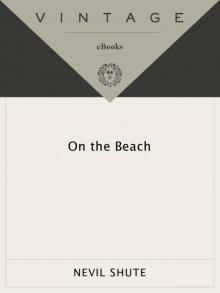 On the Beach
On the Beach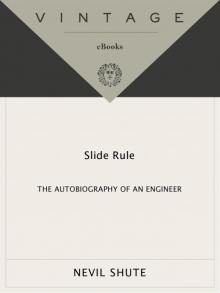 Slide Rule
Slide Rule A Town Like Alice
A Town Like Alice The Far Country
The Far Country Pied Piper
Pied Piper Round the Bend
Round the Bend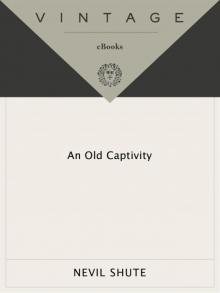 An Old Captivity
An Old Captivity Mysterious Aviator
Mysterious Aviator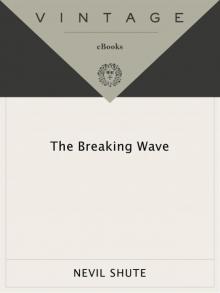 The Breaking Wave
The Breaking Wave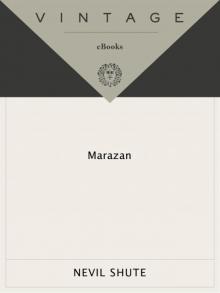 Marazan
Marazan Lonely Road
Lonely Road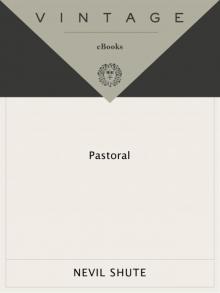 Pastoral
Pastoral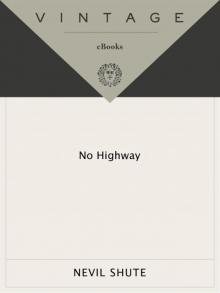 No Highway
No Highway Stephen Morris and Pilotage
Stephen Morris and Pilotage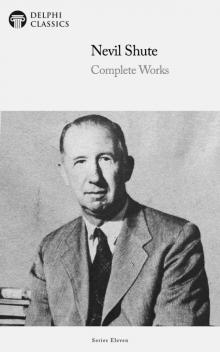 Complete Works of Nevil Shute
Complete Works of Nevil Shute Most Secret
Most Secret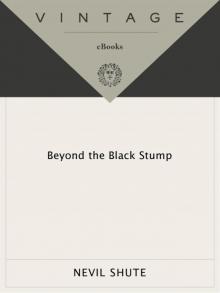 Beyond the Black Stump
Beyond the Black Stump The Rainbow and the Rose
The Rainbow and the Rose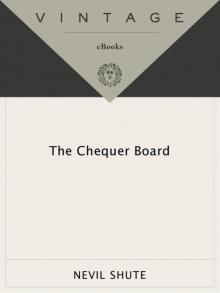 The Chequer Board
The Chequer Board Trustee From the Toolroom
Trustee From the Toolroom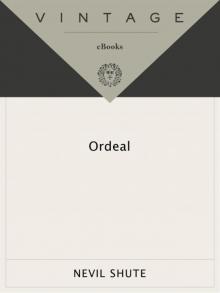 Ordeal
Ordeal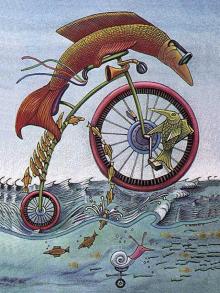 Stephen Morris
Stephen Morris